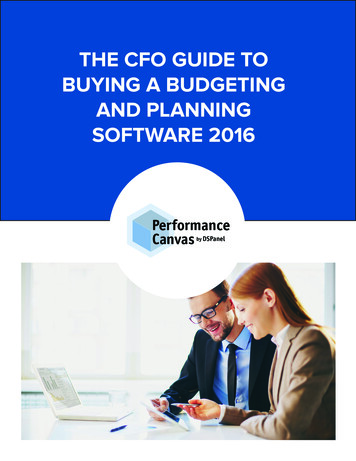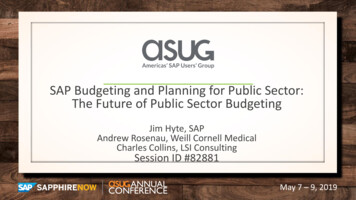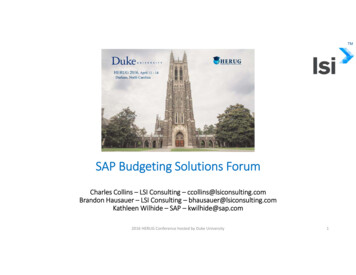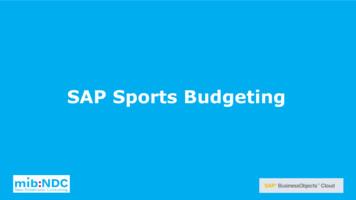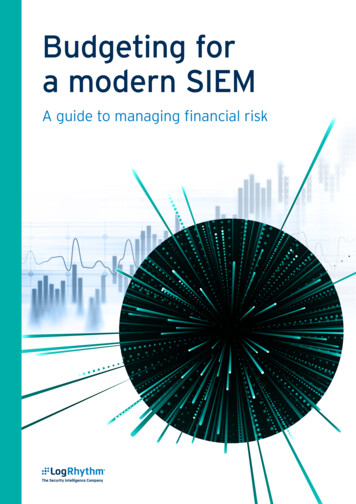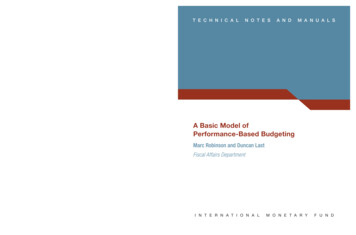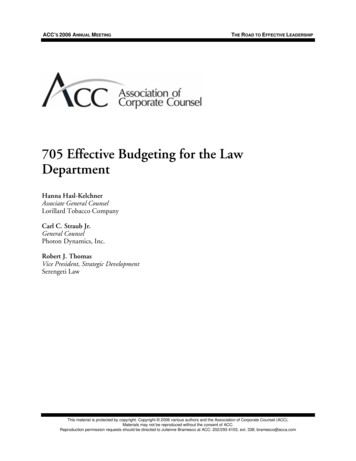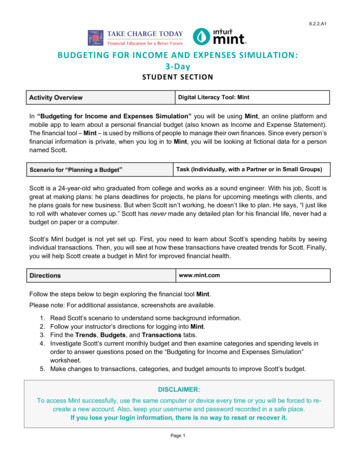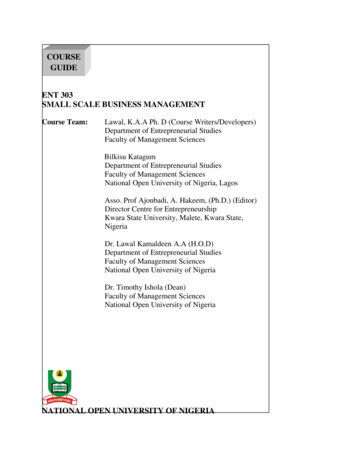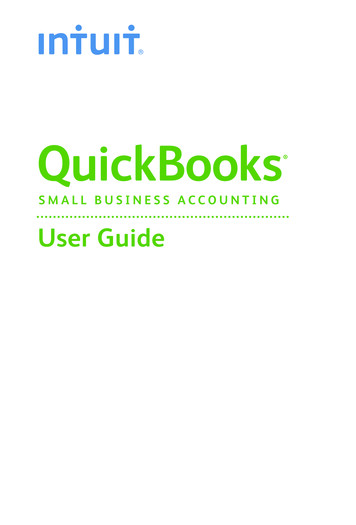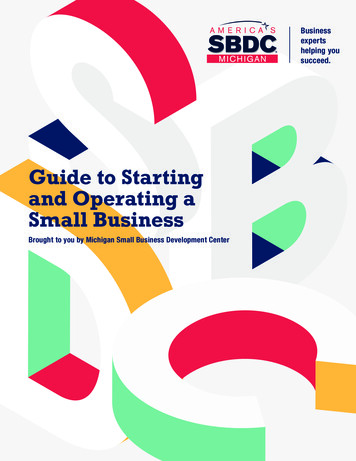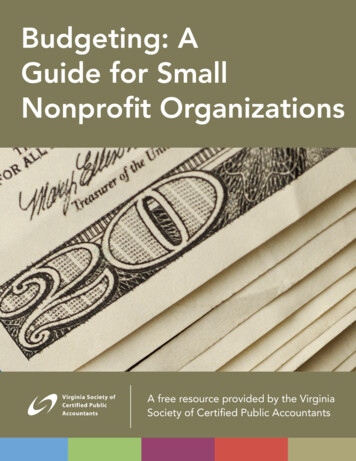
Transcription
Budgeting: AGuide for SmallNonprofit OrganizationsA free resource provided by the VirginiaSociety of Certified Public Accountants
Budgeting: A Guide for SmallNonprofit OrganizationsA free resource provided by the VirginiaSociety of Certified Public AccountantsIntroduction Selecting the budget committee The task of the budget committee Setting budget priorities and realities —revenues Setting budget priorities and realities —expenses and costsits missions. The example of Goodworks should provideguidance for many NPO budget situations.Selecting the Budget CommitteeA budget is a planning tool for the NPO. The budget committee should reflect the collective knowledge of the organization concerning the goals and objectives for the periodin question. Volunteers who serve on the budget committee should have the following qualities: A familiarity with prior years’ activities and thechanges that are contemplated in the year(s) to come,particularly the objectives in the strategic plan A desire to serve the organization as a whole ratherthan to lobby for a particular project A knowledge of ordinary budgeting, whether on thepersonal or business level When to prepare the budget A budget for cash flow A budget for capital expenditures —bought or received Restricted grants Changes to the budget ConclusionsIntroductionNonprofit organizations (NPO) wrestle continually withmaintaining and improving their operations, especially during today’s uncertain economy. In short, NPOs must constantly strive for sustainability. A well-planned budget willfocus on the primary goals and objectives of the organization and provide financial and programmatic adaptability —key ingredients to maximum sustainability.While the qualities listed above are desirable, their absenceshould not preclude excellent service by volunteers whoare otherwise interested and dedicated, especially if thevolunteers have a desire and willingness to learn aboutbudgeting.The Task of the Budget CommitteeThe task of the budget committee is to develop the budgetfor the next year (or future years, in the case of a multi-yearbudget). The steps in developing a budget are as follows: Define the budget timeline. Develop a list of objectives or goals for the year. A familiarity with prioryears’ activities and the changes that are contemplated in the year(s) to come are necessary to preparea comprehensive budget. If the organization has astrategic plan, consider activities in the plan that willimpact the budget and plan accordingly. Estimate the cost or resources required to achieveeach objective or goal. The previous year’s actualexpense or budget can be used as a starting point,but the NPO should make budgeting decisions basedon many factors, not just the prior year’s budget. Ifthe objective or goal involves new programs or activities, estimate the cost by creating an itemized listof all the expenses involved in achieving thatparticular objective. Estimate the expected dates and amounts of revenue that will be generated. Compare the expected dates and amounts of revenue to the estimated expenses and ensure that theestimated expenses are lower than the estimatedrevenues. Develop the final budget.An organization’s financial plan should include budgets foroperations and capital. The operating budget reflects theorganization’s planned financial activities for a year, showing how much revenue it expects from which sources andhow much it will spend on operations. The capital budgetmay include projects which will have ongoing effects onoperations.This guide is written to present the theories and practicalities of budgeting for the NPO staffed by volunteers, whoseexpertise do not always correspond with the budgetingneeds of the organization.In this guide, Goodworks, Inc., is a hypothetical NPO thatreceives funds from grants, the general public and sales oflogo items. These funds pay for the programs that support2
Present the budget to the board for approval.A final budget should be approved by the board before the start of the organization’s next fiscal year.The timeframe for the budget process generally will consider the calendar year, the fiscal year and the approvalprocess. The calendar year often determines the timing ofcertain expenses and revenues, particularly end-of-year taxdeductible donations. The fiscal year is the period that theNPO uses to measure funds: the federal government has afiscal year that ends Sept. 30, while many NPOs have a fiscal year that ends June 30. A fiscal year ending June 30 isparticularly appropriate for NPOs that intend to completetheir audit prior to the deadline of mid-January, a commondeadline to submit grant applications. The time requiredfor the approval process generally will determine how longbefore the end of the fiscal year it must begin.For example, Goodworks receives a grant from the UnitedWay, but Goodworks’ fiscal year might end at a differenttime than when the United Way requires annual auditedfinancial statements. In such a case, the budget processfor the following fiscal year might begin as the currentyear’s United Way statements are prepared. Goodworks’fiscal year ends June 30, but it will submit the United Wayapplication on Jan. 15. Then Goodworks might begin itsbudget process on Feb. 1, once approval is received.The need to present the budget to the board forapproval will be the overriding constraint in planning thetimeframe for the budget process. There must be time toconsider, question and change the budget both beforeand after the presentation to the board. A minimum ofthree months should be allowed for the process. A wiseboard that demands full financial statements each monthshould have a good understanding of the previous year’smonthly cash flows and the budget categories that wereover- or underfunded.Setting Budget Priorities and Realities— RevenuesThe budget committee will need to examine the reasonable expectations of revenue. Each potential source ofrevenue must be examined to determine possible enhancements in the future. Typical sources of revenue arecontributions from the public, grants and endowment/restricted funds income (based on the organization’sspending policy), ticket sales, auction proceeds and feesfor goods and services. When evaluating each source ofrevenue, the following questions should be asked:Public contributions: How much do we expect in contributions from thepublic? Are the expectations realistic? Is there a history ofincreases in past years? What about the economy? Has a major contributor had a good year or a badyear financially? What are the fundraising possibilities of the organization itself? What are the costs of fundraising?Grants and restricted funds: Can the NPO comply with the grantor’s requirements? (For example, does the NPO have adequatefunds if matching contributions are required or doesit have metrics to prove it’s meeting the grantor’sperformance standards?) Do separate accounting reports need to be providedto the grant-giving organization? Is the use of funds restricted to a particular purpose(e.g., scholarships or building)? Does the grant provide an allowance for overheadexpenses of the organization? Must the organization be audited in order to qualifyfor the grant? Does the grant lead to sustainability, allowing for thecreation of a program that can be carried on financially after the grant funds are used? Will the grant lead contributors to believe their contributions are not needed? Could the grant overwhelm the organization? Sometimes the administration of grants, particularly grantsfrom large government agencies, are beyond thetechnical skills of most small NPOs.Ticket sales, auction proceeds and fees for goods andservices: What are the revenue expectations? Are the expectations realistic? Is there a history ofsuccess with similar events or products in past years? What are the legal and tax implications of the sale? Are "suggested donations" better than a fee for aproduction or fundraiser? What are the costs associated with the production orsale?These questions require knowledge of program plans,fundraising expectations, development activities, grantsources, and local and state laws. Accurate answers are3
essential and research may be necessary. Some of thesequestions can be answered directly from the accountingsystem. Others will require input from fundraisers and/orgrant writers.A complete and accurate database of contributors canbe very helpful in forecasting estimated revenues fromdonors through general contributions, pledges and grants.Records can be tracked in a simple spreadsheet or usingsophisticated accounting software with a Customer Relationship Management (CRM) module.Setting Budget Priorities andRealities — Expenses and CostsUsually revenues and expenses are tied together, as infundraising projects that generate revenue at a certaincost. Excess revenue over expenses can usually be usedto cover other expenses of the organization — forexample, programs that do not generate revenue andadministrative expenses.Especially when identifying excess revenue to allocate toother costs in the budget, the NPO will need to be carefulit doesn’t overlook any expenses. It is important to reviewthe bylaws of the NPO for requirements that may placean undue burden on the organization, such as the requirement to have an annual audit by a paid professional ratherthan by a free, independent volunteer. Also, become familiar with the different types of expenses the organizationwill need to anticipate during the budget year:4 Direct costs relate to a specific project or program.For example, Goodworks contracts for extra staff tohold a new workshop, orders supplies for a community service program and allocates staff time, designand printing costs for a new brochure. Capital expenditures for items such as cars or realestate provide benefits for the organization longafter the budget period ends. Indirect or overhead costs may not relate to a specific project but may be necessary for its completion.Items such as postage, telephone service, Internet,copier usage or management staff time may be overlooked in the planning process. In-kind contributions of goods or services (“free”expenses and costs) should be budgeted at fairmarket value (FMV) for the new Form 990. Theseexpenses and costs can include items such as officespace, utilities, parking, security, staff hours, computers and other items provided by donors or a parentNPO. While these in-kind contributions may nothave a bottom-line impact (as they are recorded asa revenue when received and as an expense whenused, typically in the same period), NPOs should stillbudget for and report these contributions when theycan be adequately documented. This will give a moreaccurate picture of the actual total cost for the organization to meet its goals, and whether it qualifies forForms 990-N, 990-EZ or 990.As noted in the revenue section, some programs arefunded entirely by grants. The budgets for specific grantprograms are made at the time of the grant application.These budgets should include not only requests for thespecific costs of the program, but also enough to coverthe internal costs of administering the program if the grantwere awarded. Many programs have been granted basedon direct costs, without any consideration of the indirectcosts and the incidentals that can add up quickly and overwhelm a well-planned effort.The costs of managing the grants can be built into theproposal, and for complex programs, the managerial feeswill compensate the staff for their extra hours; be sureto provide 1099-MISCs in January for all the staff andcontractors who helped manage the grant. Even withoutreimbursements for managerial expenses, grant programsshould never be declined solely because they do not coverall indirect costs.Planning for programs that are to be covered by generalcontributions and unrestricted grants entails a budget thathas some elasticity to accommodate the unexpected.When to Prepare the BudgetA budget is a planning tool and should be prepared wellin advance. Plenty of time should be allowed for presenting the budget to the board of directors for approval, andfor making changes. After your hard work preparing thebudget, it may be difficult to recognize good suggestionsfor improvement, but you must be willing to go back tothe drawing board.Once the budget is prepared and approved, don’t put itaway in a dark corner. For the budget to be useful andeffective, everyone should take it seriously. The budgetshould be compared with the actual experience on aregular basis (i.e. monthly or quarterly) to allow boardmembers and executive officers to measure whether theorganization’s goals, set by the budget, are being met.An example of such a report is shown on the next page.Variances from the budget are reasonable and expected.It is rare that the assumptions made during the budgetingprocess become reality. Variances provide valuable information to improve decision-making for the remainder ofthe budget period.
Goodworks, Inc. Comparative Income Statement with Budget 2011ActualBudgetVariance25,00027,500(2,500)Grants 7,500(2,175)10,00012,000(2,000)Office expense1,1201,000120Cost of goods sold g12,00012,0000Bus 0(70)IncomeContributionsTotal incomeExpensesStaffMisc. supportTotal expensesExcessIdeally, with every presentation of financial information,there should be a comparison of actual revenue andexpenses to those budgeted. Other reports may include acomparison of the actual and budget amounts attributableto the same period in previous years and a comparison ofprojected actual to budget for the entire budget period.ensure cash will be there when needed. If an organization expects all of its expenses in the first three months ofthe year and all of its revenue in the last three months ofthe year, the organiz
Nonprofit organizations (NPO) wrestle continually with maintaining and improving their operations, especially dur-ing today’s uncertain economy. In short, NPOs must con- stantly strive for sustainability. A well-planned budget will focus on the primary goals and objectives of the organiza-tion and provide financial and programmatic adaptability — key ingredients to maximum sustainability .
